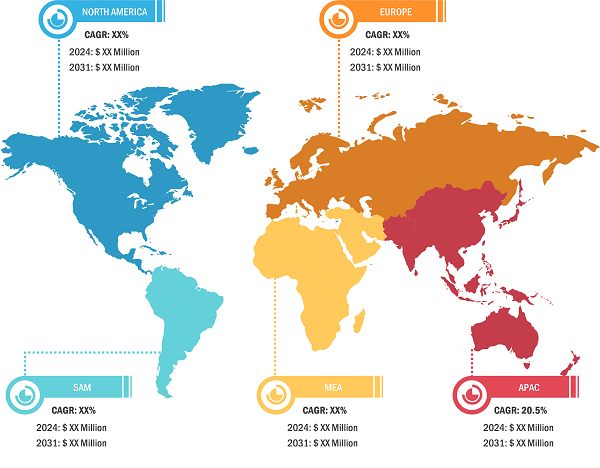Rising Adoption in Smartphones Fuel eSIM Market Growth
According to our latest study, "eSIM Market Size and Forecast (2021–2031), Global and Regional Share, Trend, and Growth Opportunity Analysis – By Component, Type, and Geography," the market was valued at US$ 5.51 billion in 2024 and is expected to reach US$ 17.98 billion by 2031. The market is estimated to register a CAGR of 18.7% during 2025–2031. The report includes growth prospects owing to the current eSIM market trends and their foreseeable impact during the forecast period.
The integration of eSIM technology in smartphones is increasing across the world. As leading smartphone manufacturers continue to embed eSIM functionality in their latest models, consumer awareness and adoption have risen significantly. This shift marks a departure from traditional SIM cards, offering enhanced flexibility, security, and a seamless user experience. According to Telna, Inc., ~98% of all smartphone connections in North America will utilize eSIM technology by 2030. Google has played a pioneering role in driving eSIM adoption within the Android ecosystem, launching the first eSIM-enabled smartphone, the Google Pixel 2, in 2017. Since then, Google has consistently expanded eSIM support across its Pixel series, underscoring its strategic focus on advancing toward an eSIM-only future. eSIM technology enables users to switch telecom carriers without the need for physical SIM cards, facilitating instant activation, remote provisioning, and support for multiple network profiles on a single device. This flexibility is valuable in an increasingly mobile and digital-first consumer environment. eSIMs also support dual-SIM capabilities.
eSIM Market Analysis — by Geography
eSIM Market Size and Forecast (2021 - 2031), Global and Regional Share, Trend, and Growth Opportunity Analysis Report Coverage: By Component (Hardware and Software & Services), Type (Consumer eSIMs, IoT eSIMs, and Travel eSIMs), and Geography
eSIM Market Trends & Forecast to 2031
Download Free Sample
Source: The Insight Partners Analysis
According to Mobilise Global, as of 2023, there were ~134 eSIMs-compatible smartphones with Samsung (26), Apple (25), and Google (19). Other prominent players leading the eSIM compatible smartphone include Sharp (12), Motorola (10), Oppo (7), Sony (7), Xiaomi (5), Rakuten (5), and other (18). The other players include Hammer (3), Nokia (3), Huawei (3), Honor (3), Vivo (2), Myphone (1), Oneplus (1), Doogee (1), and Fairphone (1). As per the GSMA Intelligence eSIM Market: China and Beyond Report in 2023, 139 new eSIM smartphones have been launched from 89 new models in 2022. Thus, the widespread proliferation of eSIM-compatible smartphones creates a strong foundation for eSIM integration and propels the eSIM market growth.
Giesecke Devrient GmbH, Telefonica SA, Deutsche Telekom AG, IDEMIA France SAS, Infineon Technologies AG, Vodafone Group Plc, NXP Semiconductors NV., KORE Wireless, STMicroelectronics NV, and Thales SA are among the key players profiled in the eSIM market report. Other major players were also studied and analyzed in the market study to get a holistic view of the market and its ecosystem.
The report includes the eSIM market forecast by component, type, and geography. Based on component, the market is divided into hardware and software & services. In terms of revenue, the hardware segment held the largest eSIM market share and is expected to register the highest CAGR during the forecast period.
The scope of the eSIM market report focuses on North America (the US, Canada, and Mexico), Europe (Spain, the UK, Germany, France, Italy, and the Rest of Europe), Asia Pacific (South Korea, China, India, Japan, Australia, and the Rest of Asia Pacific), the Middle East & Africa (South Africa, Saudi Arabia, the UAE, and the Rest of Middle East & Africa), and South & Central America (Brazil, Argentina, and the Rest of South & Central America). North America dominated the market in 2023, followed by Europe and APAC.
The market in Asia Pacific is segmented into Australia, China, Japan, India, South Korea, and the Rest of APAC. In terms of revenue, China held the largest eSIM market share in APAC. The eSIM market in China has seen notable advancements, particularly in the fields of consumer electronics and IoT, and smartphone eSIM. Progress has been most evident in remote SIM provisioning and eSIM integration in smartwatches, driven by collaboration among mobile operators, OEMs, SIM vendors, IoT companies, and technology providers. Major smartwatch vendors such as Apple, Huawei, Mobvoi, and Samsung are actively innovating in this space, and Chinese mobile operators support limited eSIM functionality through services such as “One Number for Dual Terminals,” allowing smartwatches to share mobile subscriptions with smartphones. Strong industry collaboration is helping to lay the foundation for future deployment. Key stakeholders include the Ministry of Industry and Information Technology (MIIT), GSMA, China Academy of Information and Communications Technology (CAICT), Telecommunication Terminal Industry Forum Association (TAF), and China Communications Standards Association (CCSA). The IoT sector is a major growth driver, with GSMA Intelligence projecting nearly 2 billion licensed cellular IoT connections in China by 2025—up from 700 million in 2018—underscoring the country’s pivotal role in global eSIM evolution.
Contact Us
Phone: +1-646-491-9876
Email Id: sales@theinsightpartners.com